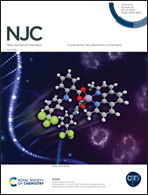A versatile fluorescence sensor for DNA detection based on layered double hydroxides and exonuclease III†
Abstract
Accurate detection of DNA is critical for biomedicine and food safety. Layered double hydroxides (LDHs) are a class of two-dimensional layered materials that have received extensive attention in the fields of sensors, catalysis, and materials science. The application of LDHs in DNA sensing in turn represents a fascinating topic. In this study, we found that both 6-carboxyfluorescein (FAM)-modified single-stranded DNA (ssDNA) probes and probe/target double-stranded DNA (dsDNA) duplexes could be adsorbed by LDHs, which resulted in high fluorescence quenching (>95%) for the first time. Based on the extraordinarily high quenching efficiency of LDHs, we developed a fluorescent sensing platform for simple and highly efficient detection of DNA, using Ni/Al-LDHs as fluorescence quenchers. For the selective degradation of dsDNA, exonuclease III was integrated into the sensor. In the sensing platform, the fluorescence of the probes was rapidly quenched by Ni/Al-LDHs. In the presence of the target DNA, dsDNA was formed, which was subsequently selectively degraded by exonuclease III into short fragments, resulting in the maintenance of the fluorescence of FAM labels. The linear range was 10–400 nM. The detection limit was 1.38 nM. This sensor accomplished the detection of target DNA within 50 min. It provides a convenient, rapid and versatile sensing platform for DNA biomarkers.



 Please wait while we load your content...
Please wait while we load your content...